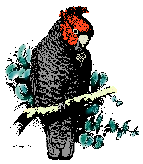|
Martin,
Sorry you are wrong. My comments are correct but
have a look at Appendix 8 of the book on page 121, which is as copied below. How
is that consistent with your wrong accusation of my book being "without any
measure of significance"? The many reviews of the GBS Report (see Appendix 9) do
not mention a lack of statistical rigour therein.
The fact remains that applying analyses to the
regressions of the species trends graphs is simply beyond the scope of the size
of the book and the intended non-technical audience, not all of whom have
studied statistics. Besides as the book clearly states bird populations did not
start in 1981 nor finish in 2002. There is no practical reason to particularly
assume that the trends for any one species would follow a linear trend of
increase or decrease throughout that time. However in some aspects that still
forms a useful model. The other point to be aware of is that many species, such
as the Pied Currawong, the seasonal variations in abundance is far greater than
the long term changes. When statistical models asses this, the perceive the
seasonal variations as random, rather than regular and therefore do not show the
trends as significant.
Extract follows (I hope it does not lose its
formatting and comes through as a neat table).
The data shown in Figures: 4, 8, 23, 26, 28, 29 & 30 represent
information that can be assessed with regression analysis. This method can
calculate the line of best fit, which is included in these graphs (not Figure
23). It can also demonstrate how well they fit to this straight line. In each
case the X & Y axes are as shown in the graph. The regression line is given
by the standard formula of Y = a + bX. The values of a (intercept on Y
where X = 0) and b (slope of the line), n (the sample size),
f value from the Analysis of variance (ANOVA) table and the probability
p significance of that f value are given, with a comment. High f
values and low p values mean the regression line is a good fit to the data. Note
that the p column includes powers of ten, so that 1.46, E-04 is 0.000146. Common
practice gives p < 0.05 as significant.
|
Figure |
Page |
a |
b |
n |
f |
p |
Significance |
|
4 |
25 |
0.687 |
0.0094 |
20 |
22.974 |
1.46, E-04 |
High |
|
8 |
26 |
-14.343 |
43.6632 |
294 |
8439.616 |
1.6, E-217 |
Huge |
|
23 |
40 |
25.473 |
0.3877 |
1316 |
167.952 |
3.10, E-36 |
Huge |
|
26 |
41 |
7.156 |
0.9778 |
294 |
2264.463 |
1.34, E-139 |
Huge |
|
28 |
42 |
120.030 |
0.0070 |
21 |
11.148 |
0.0034 |
High |
|
29 |
42 |
13.959 |
0.2071 |
21 |
90.967 |
1.12, E-08 |
Very high |
|
30 |
43 |
82.665 |
-0.0025 |
21 |
1.406 |
0.2503 |
Not |
|

